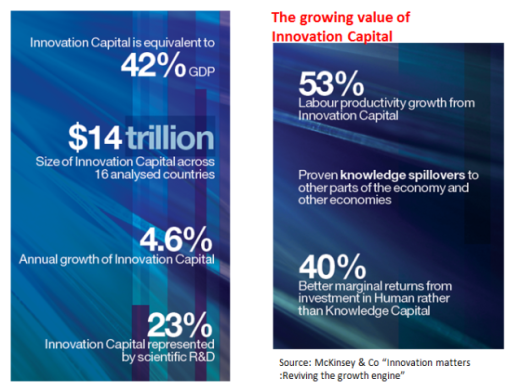 Recognizing the value of our innovation-related assets is where the smart money should go, and then we need to invest in innovation capital. To gain growth and improve productivity is through innovation. We need to translate knowledge into new values.
Recognizing the value of our innovation-related assets is where the smart money should go, and then we need to invest in innovation capital. To gain growth and improve productivity is through innovation. We need to translate knowledge into new values.
When you pause and consider the make-up of Innovation Capital you realize it makes such an economic contribution and in a report from McKinsey & Co, they have set about identifying this to produce the above summary, covering 16 countries, to understand the real value of this Innovation Capital.
These numbers are big and still don’t fully capture everything associated with innovation as much remains ‘hidden’ or ‘attached’ to other activities as well.
We need to shift our thinking on what makes up Innovation Capital
The shift taking place in recognizing that our capital is well beyond ‘just’ financial is rapidly altering organization investment decisions. The McKinsey approach has set about capturing a broader understanding of innovation than R&D alone.
Innovation and its value creation goes well beyond just R&D, it is made up of a broad range of intangible assets that are firm-specific and due to this, they are being recognized as hard to replicate, providing a growing edge over competitors if they are identified and invested in correctly.
In this report they considered the broader aspects of Innovation Capital capturing software, design, market research, training and new business processes as well as spending by governments and through tertiary education in science, technology, engineering and mathematics (STEM) subjects.
The value of this inclusive approach
By taking this inclusive approach to innovation spending they were suggesting allowed them to document better the investments underlying innovation, to see the greater “innovation infrastructure”
We are clearly seeing the continued increase in the valuations given to certain organizations, up to 80% of the value is coming from the intangibles, with the vast majority of our business organizations are really slow in getting to grips with identifying what is making up this value in their premium.
The urgency for us all, each organization, is to identify the investments and the returns as the innovation impact offered by McKinsey’s report is delivering a significant business case for understanding and recognizing the strategic importance of identifying and developing all your innovation capital.
Just go back and re-look at the graphic above for investing in Innovation Capital for its impact and implications for each of us.
Recognizing Innovation Capital is really important
So the make-up of innovation capital is big, I mean really big, this might help generate a greater innovation wake-up call. In a report from McKinsey and Co, called “Innovation matters: Reviving the growth engine” and first presented at the G8 leaders Innovation Conference, in London on 14 June 2013.
This report quantifies the importance of innovation in driving productivity growth and sets out the actions that governments and societies can take to build “Innovation Capital.”
The paper offered is stimulating the need for building the “innovation infrastructure” for our growth and as a key capability for our organizations and countries.
Where to start in specifically identifying Innovation Capital?
Within the McKinsey report they break down Innovation Capital into three components. These are:
Physical Capital is formed by investments in information and communication equipment (ICT) and across the countries analysed it represents 16 per cent of the Innovation Capital.
Knowledge Capital is formed by investments that build firms’ intellectual property and brand equity, including investments in computerized information, R&D and marketing investments, as well as relevant research in universities. It represents 60 per cent of Innovation Capital across the countries McKinsey analyzed.
Human Capital is formed by investments in building individual or organizational skills that drive productivity growth. This includes public and private investments in tertiary STEM education, employer-based training programmes and investments to develop organizational efficiencies (e.g., redesign of business processes or review of business models more broadly). Across countries analysed it represents 24 per cent of Innovation Capital.
It is important to recognize that McKinsey has captured and measured these to produce the impressive impact that innovation capital has. Is your organization identifying these for assessing their innovation capital? Most probably not.
Finding our innovation uniqueness
The make-up of our Innovation Capital are unique to each organization and highly valuable, I’d argue the report by McKinsey on its contribution is still significantly understated but a terrific step forward in attempting to quantify it.
It is the pivotal role of people as innovation carriers – their networks, collaborations, knowledge flows, interactions and tacit knowledge – and how innovation itself is a potent competitive force that drives productivity.
All this is often hidden in plain sight as our people are innovation’s active ingredient, the catalyst that turns novelty into real benefits.
Innovation capital is a big win if we can harness it well.